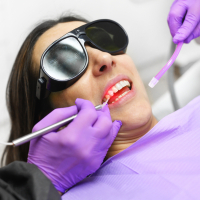
Authors: Pia‐Merete Jervøe‐Storm, Jennifer Bunke, Helen V Worthington, Raluca Cosgarea, Ian Needleman, Laura MacDonald, Tanya Walsh, Sharon R Lewis, Søren Jepsen
Antimicrobial photodynamic therapy as an addition to standard treatment for gum disease around natural teeth or dental implants*
Key messages
We are very unsure whether adding antimicrobial photodynamic therapy (aPDT) to standard treatment has any important benefits for adults with gum disease when compared to usual treatment alone.
What is gum disease around natural teeth and around dental implants?
Symptoms of gum (periodontal) disease include bleeding gums, swollen gums and bad breath. The infection can damage the soft tissues around the teeth, and in some cases people may lose their teeth. Many people with a dental implant (a false tooth that is fixed in the gum) will be affected by this kind of disease around the implant.
How is gum disease treated?
As well as advice to brush teeth twice a day and regularly floss between teeth, people may need treatment for gum disease from their dentist. Standard periodontal treatment includes scraping any bacteria from the infected areas of the mouth using hand instruments or power‐driven instruments. People may also need to take antibiotics, but because of increasing resistance of bacteria to antibiotics, alternative additional treatments may help.
Antimicrobial photodynamic therapy (aPDT) combines a light‐absorbing dye (applied to the affected areas of the mouth after bacteria have been removed) and a light source (typically a low‐energy diode laser device).
What did we want to find out?
We wanted to find out if aPDT added to standard treatment is more effective than standard treatment alone for people with gum disease. We were interested in the long‐term effects of using additional aPDT so we looked at results six months after treatment. We looked at the difference in the depth of pockets (spaces around the teeth caused by gum disease), bleeding (after gentle probing of the affected sites), attachment of the tooth to the bone, the amount of gum that has pulled away from the tooth (gum recession) and how many pockets had closed after treatment. We also wanted to find out if there were any harms associated with using aPDT.
What did we do?
We searched for studies in adults with gum disease or disease around dental implants. We included studies that compared aPDT given after standard treatment versus standard treatment alone. We compared and summarised the results according to whether the treatment was given to people who had never been treated for gum disease (active treatment) or people who were receiving long‐lasting care (supportive treatment). We rated our confidence in the evidence based on factors such as study methods and sizes.
What did we find?
We included 50 studies involving 1407 adults. In most studies, aPDT was carried out in a single session. In 11 studies, people had multiple sessions of aPDT (two, three or four sessions). Most studies involved non‐smokers. None of the people in the studies had taken antibiotics in the six months before they enrolled in the study. One very small study involved people who had swelling around dental implants. All other studies involved people with gum disease around natural teeth.
What were the main results?
During active treatment of gum disease, we are very unsure whether additional aPDT has any important benefits at six months compared with standard treatment. This includes change in the depth of pockets, bleeding, attachment of the tooth to the bone and gum recession.
We are also very unsure about the findings for the same measurements at six months during the supportive phase of gum disease treatment.
In one study, a participant developed an abscess (a swelling at one tooth), but it is not clear if this was related to aPDT. Other studies observed no harms related to aPDT. No studies reported information about how many pockets had closed six months after treatment.
What are the limitations of the evidence?
We are not confident in the evidence because some studies may not have been well conducted and they included only very small numbers of people. We also found that there were differences between the results of many of the studies and we could not explain what caused this variation.
How up‐to‐date is this evidence?
This evidence is current to 14 February 2024.
*This is a plain language summary of a review that is published in the Cochrane Library. You can find the full report of the review here: https://www.cochranelibrary.com/cdsr/doi/10.1002/14651858.CD011778.pub2/full?highlightAbstract=antimicrobial%7Cphotodynam%7Ctherapy%7Ctherapi%7Cantimicrobi%7Cphotodynamic
